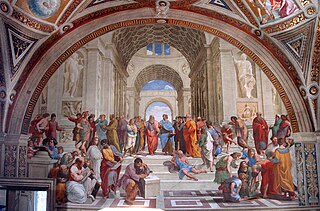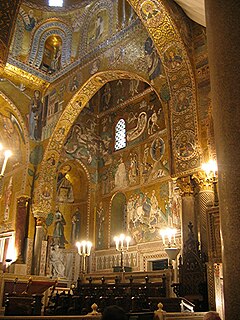 W
WChristianity and Islam are the two largest religions in the world, with 2.4 billion and 1.9 billion adherents respectively. Both religions are considered as Abrahamic, and are monotheistic, originating in the Middle East.
 W
WThe Ascension of Jesus is the Christian teaching that Christ physically departed from Earth by rising into Heaven, in the presence of eleven of his apostles. According to the New Testament narrative, the Ascension occurred on the fortieth day counting from the resurrection. In the Christian tradition, reflected in the major Christian creeds and confessional statements, God exalted Jesus after his death, raising him from the dead and taking him to Heaven, where Jesus took his seat at the right hand of God.
 W
WThe Ashtiname of Muhammad, also known as the Covenant or Testament (Testamentum) of Muhammad, is a document which is a charter or writ written by Ali and ratified by Muhammad granting protection and other privileges to the followers of Jesus the Nazarene, given to the Christian monks of Saint Catherine's Monastery. It is sealed with an imprint representing Muhammad's hand.
 W
WBahira was an Arabian Nestorian or possibly Gnostic Nasorean monk who, according to Islamic tradition, foretold to the adolescent Muhammad his future as a prophet. His name derives from the Syriac bḥīrā, meaning “tested and approved”.
 W
WChristian influences in Islam could be traced back to the Eastern Christianity, which surrounded the origins of Islam. Islam, emerging in the context of the Middle East that was largely Christian, was first seen as a Christological heresy known as the "heresy of the Ishmaelites", described as such in Concerning Heresy by Saint John of Damascus, a Syriac scholar.
 W
WChristianity and Druze are Abrahamic religions that share a historical traditional connection with some major theological differences. The two faiths share a common place of origin in the Middle East, and consider themselves to be monotheistic.
 W
WUnder the Ottoman Empire's millet system, Christians and Jews were considered dhimmi under Ottoman law in exchange for loyalty to the state and payment of the jizya tax.
 W
WThe Church of San Buenaventura in Casablanca, Morocco was founded by Franciscan Catholics around 1890. Built on territory Sultan Hassan I of Morocco granted to King Alfonso XII, it was the seat of the Spanish church in Casablanca from the late 19th century.
 W
WThere was cultural contact between Europe and the Islamic world from the Renaissance to Early Modern period.
 W
WThe Elephant in the Dark is a book by the writer Idries Shah, based on lectures he delivered at the University of Geneva as Visiting Professor in 1972–1973. He was invited to speak on the topic of “Salvation as a total surrender to God: an attempt at dialogue between Christians and Muslims.”
 W
WAccording to Islamic sources, the event of Mubahala was a meeting between the Islamic prophet Muhammad and a Christian delegation from Najran, in the month of Dhu'l-Hijja, 10 AH, where Muhammad called for invoking a curse to reveal who was lying about their religious differences.
 W
WThe House of One is a religious structure being built in Berlin. It will be the world's first house of prayer for three religions, containing a church, a mosque, and a synagogue.
 W
WDuring the high medieval period, the Islamic world was at its cultural peak, supplying information and ideas to Europe, via Al-Andalus, Sicily and the Crusader kingdoms in the Levant. These included Latin translations of the Greek Classics and of Arabic texts in astronomy, mathematics, science, and medicine. Translation of Arabic philosophical texts into Latin "led to the transformation of almost all philosophical disciplines in the medieval Latin world", with a particularly strong influence of Muslim philosophers being felt in natural philosophy, psychology and metaphysics. Other contributions included technological and scientific innovations via the Silk Road, including Chinese inventions such as paper and gunpowder.
 W
WIslamic influences on Western art refers to the influence of Islamic art, the artistic production in the Islamic world from the 8th to the 19th century, on Christian art. During this period, the frontier between Christendom and the Islamic world varied a lot resulting in some cases in exchanges of populations and of corresponding art practices and techniques. Furthermore, the two civilizations had regular relationships through diplomacy and trade that facilitated cultural exchanges. Islamic art covers a wide variety of media including calligraphy, illustrated manuscripts, textiles, ceramics, metalwork and glass, and refers to the art of Muslim countries in the Near East, Islamic Spain, and Northern Africa, though by no means always Muslim artists or craftsmen. Glass production, for example, remained a Jewish speciality throughout the period, and Christian art, as in Coptic Egypt continued, especially during the earlier centuries, keeping some contacts with Europe.
 W
WThe Quran mentions the Torah ("Tawrat"), the Zabur ("Psalms") and the Injil ("Gospel") as being revealed by God to the prophets Moses, David and Jesus respectively in the same way the Quran was revealed to Muhammad, the final prophet and messenger of God according to Muslims.
 W
WThe Kosovo Myth, also known as the Kosovo Cult and the Kosovo Legend, is a Serbian nation-building myth based on legends about events related to the Battle of Kosovo (1389). It has been a subject in Serbian folklore and literary tradition and has been cultivated oral epic poetry and guslar poems. The final form of the legend was not created immediately after the battle but evolved from different originators into various versions. In its modern form it emerged in 19th-century Serbia and served as an important constitutive element of the national identity of modern Serbia and its politics, and in certain periods of other South Slavic nations.
 W
WDuring the Middle Ages, Christendom largely viewed Islam as a Christian heresy and Muhammad as a false prophet. Various Western and Byzantine Christian thinkers considered Muhammad to be a perverted, deplorable man, a false prophet, and even the Antichrist, as he was frequently seen in Christendom as a heretic or possessed by demons. Some of them, like Thomas Aquinas, criticized Muhammad's promises of carnal pleasure in the afterlife.
 W
WMuhammad's views on Christians were shaped through his interactions with them. According to Islamic tradition, he interacted with Christians while in Mecca and viewed Christians as People of the Book and as earlier receivers of Abrahamic revelation.
 W
WArguments that prophecies of Muhammad exist in the Bible have formed part of Muslim tradition from the early history of Muhammad's Ummah. A number of Christians throughout history, such as John of Damascus and John Calvin, have interpreted Muhammad as being the Antichrist of the New Testament.
 W
WThe Regensburg lecture or Regensburg address was delivered on 12 September 2006 by Pope Benedict XVI at the University of Regensburg in Germany, where he had once served as a professor of theology. It was entitled "Faith, Reason and the University – Memories and Reflections". The lecture is considered to be among the most important papal statements on world affairs since John Paul II's 1995 address to the United Nations, and sparked international reactions and controversy.
 W
WSaracens were primarily Arab Muslims, but also Turks, Persians or other Muslims as referred to by Christian writers in Europe during the Middle Ages. The term's meaning evolved during its history. In the early centuries of the Christian Era, Greek and Latin writings used the term to refer to the people who lived in desert areas in and near the Roman province of Arabia Petraea, and in Arabia Deserta. In Europe during the Early Middle Ages, the term came to be associated with tribes of Arabia. The oldest known source mentioning Saracens in relation to Islam dates to the 7th century. It was found in Doctrina Jacobi, a commentary that discussed the Muslim conquest of the Levant.
 W
W"Sun of Unclouded Righteousness" is a little-known 1758 Christian hymn written by Charles Wesley, the brother of John Wesley, the founder of Methodism. It was written as an intercessory hymn praying for the salvation of Muslims and calls for their conversion to Christianity. It had fallen out of use by around 1880.
 W
WPeter the Venerable, also known as Peter of Montboissier, was the abbot of the Benedictine abbey of Cluny. He has been honored as a saint but has never been formally canonized. The Catholic Church's Martyrologium Romanum, issued by the Holy See in 2004, regards him as a Blessed.
 W
WThe virgin birth of Jesus is the Christian doctrine that Jesus was conceived by his mother, Mary, through the power of the Holy Spirit and without sexual intercourse. It is mentioned only in Matthew 1:18–25 and Luke 1:26–38, and the modern scholarly consensus is that the narrative rests on very slender historical foundations. The ancient world had no understanding that male semen and female ovum were both needed to form a fetus; this cultural milieu was conducive to miraculous birth stories, and tales of virgin birth and the impregnation of mortal women by deities were well known in the 1st-century Greco-Roman world and Second Temple Jewish works.